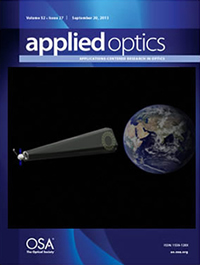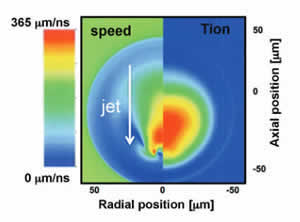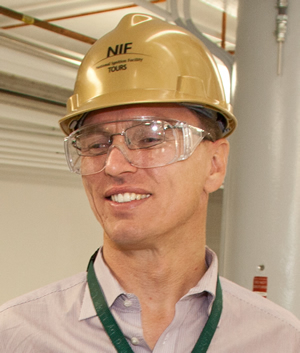Photons & Fusion Newsletter - 2014
April
Photons & Fusion is a monthly review of science and technology at the National Ignition Facility & Photon Science Directorate. For more information, submit a question.
Discovery Science on NIF: Exploring the Physics of Star Formation
For the past several years, astronomers at the University of Maryland and theorists and experimentalists at LLNL have investigated the origin and dynamics of star-forming structures such as the famous “Pillars of Creation” in the Eagle Nebula The iconic 1995 image of star-forming pillars in the Eagle Nebula captured by the Hubble Space Telescope. The largest pillar is one parsec (about 19 trillion miles) high. Credit: NASA, Jeff Hester, and Paul Scowen (Arizona State University). and similar structures at the boundaries of H II regions (emission nebulae) and molecular clouds (low-density clouds of partially ionized gas and dust).
The iconic 1995 image of star-forming pillars in the Eagle Nebula captured by the Hubble Space Telescope. The largest pillar is one parsec (about 19 trillion miles) high. Credit: NASA, Jeff Hester, and Paul Scowen (Arizona State University). and similar structures at the boundaries of H II regions (emission nebulae) and molecular clouds (low-density clouds of partially ionized gas and dust).
In an April 30 High Energy Density Science Seminar, “Dynamics of Molecular Clouds: Observations, Simulations, and NIF Experiments,” Marc Pound of the University of Maryland reviewed theories of how molecular pillars may form and presented results from recent observations and numerical simulations; and Jave Kane of LLNL described scaled Eagle Nebula experiments designed to recreate the pillars in miniature inside the NIF Target Chamber—one of several discovery science campaigns currently being conducted on NIF.
The NIF laser will be used to create an intense star-like source that will illuminate a nebula-like target, creating tenuous “rocket” plumes of material. The goals are to discover whether the pillars may be formed from a dense cloud core, resembling the head of a comet, with accelerating matter stretched out like a comet’s wispy tail, or might instead be caused by more exotic, theorized nonlinear instabilities that could explain star formation in the pillars.
Kane discussed NIF experiments that will generate “cometary” structures and presented results from experiments on the OMEGA EP laser system at the University of Rochester that validated the experimental concepts to be used in the NIF experiments. They include a 30-nanosecond, multi-hohlraum x-ray drive and a “NIF Science Eagle” package with dense clumps in foam, stood off from the hohlraum source so it is illuminated by directional radiation.
“The experimental foundation has been laid” for the NIF experiments, Kane said.
 Marc Pound introduces his presentation on theories of star formation.
Marc Pound introduces his presentation on theories of star formation. Article on MOIRE Optics on Cover of Applied Optics
A paper by LLNL researchers and collaborators describing the optics technology being developed for the Defense Advanced Research Projects Agency (DARPA)’s Membrane Optical Imager Real-time Exploitation (MOIRE) program is the cover article in the April 10 issue of Applied Optics.

The MOIRE program seeks to further the technology development related to ultralight diffractive membrane-based telescopes to provide geosynchronous-orbit Earth observation capabilities. Ball Aerospace, supported by LLNL, NeXolve Corporation, and Alliant Techsystems Inc., is now in phase 2 of a MOIRE contract to demonstrate a ground-based telescope utilizing segmented membrane diffractive primary lenses.
The membrane optic diffractive imager provides increased aperture at lower mass and cost compared to conventional systems, and can enable persistent coverage from geosynchronous orbit.
The researchers have demonstrated 4-level Fresnel zone lenses (FZLs) in glass with a minimum linewidth of one micron, using a commercial laser photoplotter with overlay writing capability and ion-beam etching for pattern transfer.
“The tooling is capable of producing FZL patterns up to 780mm square on substrates 800mm square, with diffraction-limited performance and near-theoretical diffraction efficiency,” the researchers said. “Replication of master 4-level patterns in 355-mm-diameter, 20-micron-thick, 0-CTE (coefficient of thermal expansion) polymer films has also been demonstrated with >55 percent diffraction efficiency into the −1 order, again using tooling capable of producing 800-mm-diameter optics. This type of optic can present a path forward for ultralight very-large aperture segmented space-based imaging telescopes.”
Lead author Jerry Britten was joined on the paper by LLNL colleague Sham Dixit and by collaborators from Advance Reproductions Corp. of Andover, Mass., NeXolve Corp. of Huntsville, Ala., and Ball Aerospace and Technologies Corp. of Boulder, Colo.
 Upon arrival in orbit, the MOIRE spacecraft would deploy solar arrays and then unfurl a micrometer-thin diffractive optic membrane to form a massive segmented light collection lens. (Credit: DARPA)
Upon arrival in orbit, the MOIRE spacecraft would deploy solar arrays and then unfurl a micrometer-thin diffractive optic membrane to form a massive segmented light collection lens. (Credit: DARPA) Mode 1 Drive Asymmetry in NIF Inertial Confinement Fusion Implosions
In order to achieve inertial confinement fusion (ICF) ignition on NIF, the implosion must have nearly spherical symmetry. A radiation drive asymmetry (pole-to-pole imbalance, also known as “mode 1”) could result from non-uniform laser power delivered to the hohlraum, target displacement from Target Chamber center, or deuterium-tritium cryogenic ice layer asymmetry.
Numerical simulations of implosions perturbed by mode 1 drive asymmetry show appreciable disturbances to the implosion hydrodynamics. The hot spot is displaced, the areal density evolves asymmetrically, and a low-density jet is driven through the hot spot. This damages the hot spot energetics, causing reduced internal energy and increased residual, wasted kinetic energy. This loss of energy conversion to hot spot internal energy damages the implosion, resulting in substantial neutron yield reduction.
 Simulations show that drive asymmetry drives a strong jet of low-density fuel through the central hot spot. The kinetic energy stored in the jet represents lost internal energy in the hot spot. The jet damages the implosion and alters the ion temperature (Tion) distribution (shown here varying from 300 to 4,000 electron volts).
Simulations show that drive asymmetry drives a strong jet of low-density fuel through the central hot spot. The kinetic energy stored in the jet represents lost internal energy in the hot spot. The jet damages the implosion and alters the ion temperature (Tion) distribution (shown here varying from 300 to 4,000 electron volts). In a Physics of Plasmas paper published online on April 9, LLNL researchers and colleagues reported that numerical simulations of implosions with mode 1 asymmetry show that the resulting simulated diagnostic signatures are moved toward the values observed in many lower-yield NIF experiments. The diagnostic output can be used to build a set of integrated implosion performance metrics. The metrics indicate that this asymmetry has a significant impact on implosion performance and must be carefully controlled in NIF implosions.
Further development of the ability to detect and understand mode 1 perturbations is under way at NIF. Diagnostics are being examined for their capability to measure the effects of asymmetries and other diagnostics and experimental platforms are being modified to enhance their relevance for mode 1detection. NIF also has fielded a set of experiments meant to test directly the effects of drive asymmetry on implosions.
Lead author Brian Spears was joined on the paper by LLNL colleagues John Edwards, Steve Hatchett, Annie Kritcher, John Lindl, David Munro, Prav Patel, Harry Robey, and Richard Pj Town, and by Joe Kilkenny of General Atomics and James Knauer of the Laboratory for Laser Energetics (LLE) at the University of Rochester.
Metrics for Long-Wavelength Asymmetries in NIF Implosions
As noted above, maintaining symmetry of the fuel throughout an entire ICF implosion is necessary for the efficient conversion of kinetic energy into compression and heating of the fuel and hot spot. LLNL researchers and a colleague have demonstrated that the time-dependent shape over the entire implosion correlates with yield reduction due to low-mode asymmetries.
The study, reported in a Physics of Plasmas paper published online on April 25, was performed using a large database of more than 600 capsule-only, cylindrically symmetric, two-dimensional simulations conducted with the Livermore radiation hydrodynamics code HYDRA. A frequency-dependent radiation drive that has been extracted from integrated hohlraum simulations was applied to the capsules, allowing the asymmetries to be effectively “dialed in.” The asymmetries were applied to the radiation flux on the capsule at 100 microns from the ablation front.
 Cutaway view of the radiation hydrodynamics code HYDRA simulating a NIF ignition target. Representative laser rays from two beams (green, red) illuminate the hohlraum wall (gold). Their energy is converted to thermal x rays, which heat the capsule ablator.
Cutaway view of the radiation hydrodynamics code HYDRA simulating a NIF ignition target. Representative laser rays from two beams (green, red) illuminate the hohlraum wall (gold). Their energy is converted to thermal x rays, which heat the capsule ablator. The results showed that low-mode radiation-induced drive asymmetries can result in significant deviation between the core hot-spot shape and the fuel areal-density (ρR) shape at peak compression. The study also demonstrated that significant residual kinetic energy at peak compression can be induced by these low-mode asymmetries.
The researchers have developed a metric, which is a function of the hot-spot shape, fuel ρR shape, and residual kinetic energy at peak compression, which is well correlated to yield degradation due to low-mode shape perturbations. The study showed that the ρR shape and residual kinetic energy cannot, in general, be recovered by inducing counter-asymmetries to make the hot core emission symmetric, and that the yield degradation due to low-mode asymmetries correlates to measurements of time-dependent shape throughout the entire implosion, including early-time shock symmetry and in-flight fuel symmetry.
Lead author Annie Kritcher was joined on the paper by LLNL colleagues Richard Pj Town, Dave Bradley, Dan Clark, Brian Spears, Oggie Jones, Steve Haan, Paul Springer, John Lindl, Debbie Callahan, John Edwards, and Nino Landen, and by Robbie Scott of the UK’s Rutherford Appleton Laboratory.
Observations of Continuum Depression in Warm Dense Matter
Accurate knowledge of the ionization balance, thermodynamic properties, and equation of state of dense plasmas is relevant for understanding matter at pressures and temperatures that are predicted to exist in many astrophysical environments such as the interiors of giant planets, and that occur during the fuel assembly phase of inertial confinement fusion implosions.

Current NIF experiments achieve laser-driven compressed matter densities of up to 1,000 g/cm3, so it is important to experimentally characterize highly compressed states of matter to determine the physical properties and evaluate state-of-the-art radiation-hydrodynamic modeling.
In a Physical Review Letters paper published online on April 10, LLNL researchers and collaborators presented the first measurements of continuum depression in well-characterized compressed matter from spectrally resolved x-ray Thomson scattering (XRTS). As opposed to previous studies, both the elastic and inelastic XRTS features have been described for the first time, providing the ionization state with high accuracy.
The researchers compared experimental data from a pump-probe experiment performed at the OMEGA Laser Facility at the University of Rochester to three different radiation-hydrodynamic simulations. The results showed that high signal-to-noise measurements and the sensitivity of the carbon L-shell bound-free scattering spectra have accurately determined a carbon charge state of ZC=4 at pressures approaching 50 Mbar, resulting in approximately two times higher free electron density than that of standard radiation-hydrodynamic modeling. Such higher-than-predicted ionization demonstrates the utility of material compression experiments to evaluate ionization potential depression (IPD) models.
“These results have important implications for inertial confinement fusion studies where knowledge of the electron density in shock-compressed warm dense matter affects the calculation of hydrodynamic instabilities in the design of capsule implosion experiments,” the researchers said.
Lead author Luke Fletcher of SLAC National Accelerator Laboratory was joined on the paper by SLAC colleague Siegfried Glenzer; LLNL researchers Annie Kritcher, Arthur Pak, Tammy Ma, Tilo Döppner, Carsten Fortmann, Laurent Divol, Oggie Jones, Nino Landen, and Howard Scott; and collaborators from the Max Planck Institute in Germany, the UK’s Atomic Weapons Establishment, the University of Warwick, the University of Washington, and the University of Oxford.
Science on NIF Technical Review Committee Meets
 (Above) Members of the Science on NIF Technical Review Committee meet to discuss discovery science experiments. (Below) NIF&PS Laser Systems Engineer Kai LaFortune discusses the operation of the NIF laser system during an April 9 poster session.
(Above) Members of the Science on NIF Technical Review Committee meet to discuss discovery science experiments. (Below) NIF&PS Laser Systems Engineer Kai LaFortune discusses the operation of the NIF laser system during an April 9 poster session.
The Science on NIF Technical Review Committee met at LLNL on April 8-10 to provide NIF&PS management with an assessment and path forward for discovery science on NIF.
After hearing briefings on the status of the NIF facility plan, experimental platforms, and science program, the committee reviewed the progress of the current experiments and options for a new call for discovery science proposals. A poster session on NIF experimental capabilities focused on NIF platforms was held on April 9. The committee will make recommendations for the upcoming solicitation in its report.
Siegfried Glenzer Receives E.O. Lawrence Award for His Work at NIF
LLNL seismologist Stephen Myers and plasma physicist Siegfried Glenzer of SLAC National Accelerator Laboratory have received 2013 E.O. Lawrence Awards from the U.S. Department of Energy. Glenzer was honored for his work while serving as NIF plasma physics group leader.
 Siegfried Glenzer
Siegfried Glenzer Glenzer, an 18-year Lab veteran who joined SLAC last year, was cited for his development of Thomson x-ray scattering as an in situ microscopic characterization technique of dense plasma, and for its use to advance fundamental understanding in high energy density physics.
Thomson x-ray scattering is based on the interaction of electromagnetic waves, such as light, with free electrons, and is used to determine the properties of matter that has been heated and compressed to high temperatures and/or pressures, and is especially powerful in sensing the temperature of plasma—the high-temperature state of matter in which electrons and nuclei move independently of each other. The technique enables probing unusual and exotic states of matter under extreme conditions of temperature, pressure, and radiation, such as the Big Bang, the interiors of stars and planets, and thermonuclear weapons.
“The (Lawrence) Award is a great honor—not only to me, but to all the scientists with whom I was privileged to collaborate in our great endeavor to understand nature,” Glenzer said. “Our role was to be at the forefront of new experiments on NIF with the goal to develop thermonuclear burn in the laboratory.”
Glenzer acknowledged LLNL’s Laboratory Directed Research and Development (LDRD) program for its support of his work. “From the very beginning LDRD was absolutely critical to our success,” he said. “We had LDRD support for this research first as feasibility study and subsequently as exploratory research and also in the form of a laboratory-wide grant.”




